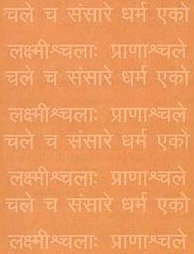Kularnavatantra, Kulārṇavatantra, Kularnava-tantra: 4 definitions
Introduction:
Kularnavatantra means something in Hinduism, Sanskrit. If you want to know the exact meaning, history, etymology or English translation of this term then check out the descriptions on this page. Add your comment or reference to a book if you want to contribute to this summary article.
In Hinduism
Shaktism (Shakta philosophy)
Source: DSpace at Pondicherry: Siddha Cult in Tamilnadu (shaktism)Kulārṇavatantra (कुलार्णवतन्त्र).—The Kulārṇava is one of the most important Tāntric works. It was composed probably before 11th Century C.E. According to the Kulārṇava, the Kuladharma is the essence of the Vedas. The Kulārṇava says that every woman is born in the kula of the Great Mother and hence she must be regarded as an object of veneration.
It refers to eighteen Śākta-pīṭhas viz.,
- Uḍḍiyāna,
- Devīkoṭṭa,
- Hiṅgulā,
- Koṭimudrā ,
- Jālandhara,
- Vārāṇasī,
- Antarvedī,
- Prayāga,
- Mithilā,
- Magadha,
- Mekala,
- Aṅga,
- Vaṅga,
- Kaliṅga,
- Siṃhala,
- Strīrrājya,
- Rādha
- and Gauḍa.

Shakta (शाक्त, śākta) or Shaktism (śāktism) represents a tradition of Hinduism where the Goddess (Devi) is revered and worshipped. Shakta literature includes a range of scriptures, including various Agamas and Tantras, although its roots may be traced back to the Vedas.
Vedanta (school of philosophy)
Source: Shodhganga: Siva Gita A Critical StudyKulārṇavatantra (कुलार्णवतन्त्र) refers to a leading scripture of the Kaula school of Śāktism focusing on ways to liberation, with chapters on Guru-Śiṣya relationship.

Vedanta (वेदान्त, vedānta) refers to a school of orthodox Hindu philosophy (astika), drawing its subject-matter from the Upanishads. There are a number of sub-schools of Vedanta, however all of them expound on the basic teaching of the ultimate reality (brahman) and liberation (moksha) of the individual soul (atman).
Languages of India and abroad
Sanskrit dictionary
Source: Cologne Digital Sanskrit Dictionaries: Aufrecht Catalogus Catalogorum1) Kulārṇavatantra (कुलार्णवतन्त्र) as mentioned in Aufrecht’s Catalogus Catalogorum:—Io. 839. Oxf. 90^b. Paris. (D 13). L. 258. 290. Bik. 592. B. 4, 254. Report. Xxix. Ben. 45. Tu7b. 11. Kāṭm. 12. Pheh. 1. Np. Vii, 50. Kāśin. 32. Oppert. 6729. 6889. Ii, 3399. 4530. Peters. 1, 114. 3, 399. Bp. 275. D 2. Quoted in Tantrasāra Oxf. 95^b, in Śaktiratnākara Oxf. 101^b, in Śāktānandataraṅgiṇī Oxf. 103^b, in Prāṇatoṣiṇī p. 2, by Pūrṇānanda L. 2067, by Gaurīkānta Oxf. 109^b. Kulārṇave Guptāmnāye Īśānasaṃhitā. L. 424.
—Kālikāsahasranāman. Oudh. Xvii, 102.
—Gaṇapatipañcāṅga. Oudh. Xvii, 104.
—Gaṇeśastava. Oudh. Xvii, 102.
—Cakrabhedanirṇaya. Oudh. Xi, 22.
—Durgādakārādisahasranāmastotra. L. 353.
—Durgāsahasranāman. Oudh. Xvii, 94.
—Devīsvarūpastuti. Burnell. 199^b.
—Śāktakrama. Oudh. Xvii, 98.
—Śyāmākavaca. Oudh. Xvii, 102.
—Samayācāra. Oudh. Xvii, 98.
2) Kulārṇavatantra (कुलार्णवतन्त्र):—read Tantrasāra Oxf. 95^a.
3) Kulārṇavatantra (कुलार्णवतन्त्र):—Io. 839. 1048. Peters. 4, 41. Stein 228. Kulārṇave Gaṇeśastavaḥ. Oudh. Xxi, 166.
4) Kulārṇavatantra (कुलार्णवतन्त्र):—Ulwar 2085.
5) Kulārṇavatantra (कुलार्णवतन्त्र):—Cs 5, 14 (inc.). 15 (Ullāsa 2). Il. Whish 42, 1.
Source: Cologne Digital Sanskrit Dictionaries: Monier-Williams Sanskrit-English DictionaryKulārṇavatantra (कुलार्णवतन्त्र):—[=kulārṇava-tantra] [from kulārṇava > kula] n. idem
Sanskrit, also spelled संस्कृतम् (saṃskṛtam), is an ancient language of India commonly seen as the grandmother of the Indo-European language family (even English!). Closely allied with Prakrit and Pali, Sanskrit is more exhaustive in both grammar and terms and has the most extensive collection of literature in the world, greatly surpassing its sister-languages Greek and Latin.
See also (Relevant definitions)
Partial matches: Kularnava, Tantra.
Full-text (+185): Tarita, Gurushripadukapuja, Jivana, Mohita, Pushpaya, Vikala, Vaidyaya, Kaunciki, Kaushaki, Kaula, Tamrakuta, Kalinga, Devikotta, Jalandhara, Vanga, Magadha, Mekala, Uddiyana, Dhanava, Radha.
Relevant text
Search found 11 books and stories containing Kularnavatantra, Kulārṇavatantra, Kularnava-tantra, Kulārṇava-tantra; (plurals include: Kularnavatantras, Kulārṇavatantras, tantras). You can also click to the full overview containing English textual excerpts. Below are direct links for the most relevant articles:
Lakulisha-Pashupata (Philosophy and Practice) (by Geetika Kaw Kher)
Kapalikas and Natha Siddhas < [Chapter 2 - Spread and Transition]
Vidhis: Use of Ashes (Meanings and Metaphors) and Nudity < [Chapter 3 - The Ritualistic Context]
Rise of Tantric Elements in Lakulisa-Pasupata order < [Chapter 2 - Spread and Transition]
Amarakoshodghatana of Kshirasvamin (study) (by A. Yamuna Devi)
Religion, Religious Myths and Legends (Introduction) < [Chapter 4 - Cultural Aspects]
Shat-cakra-nirupana (the six bodily centres) (by Arthur Avalon)
Varahi Tantra (English Study) (by Roberta Pamio)
The Brahmanda Purana (by G.V. Tagare)
Chapter 31 - Paraśurāma advised by Brahmā to approach Śiva about Haihaya < [Section 3 - Upodghāta-pāda]
Paduka-panchaka (the five-fold footstool) (by Arthur Avalon)